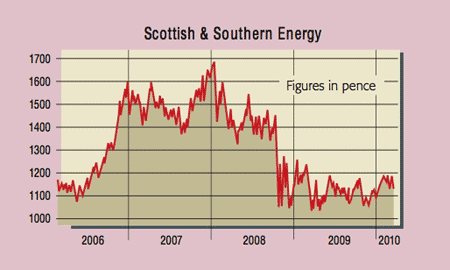This winter’s ultra-chilly cocktail of ice and snow has not been everyone’s idea of fun. But some people really relish a big freeze – namely, the bosses of the companies that provide the country with electricity and gas. For them the recent cold weather has been a big profit booster. And for investors, that’s only part of the lure of the energy sector. Not only does it offer some of the cheapest stocks around, but it throws out some of the best yielders too.
Britain’s biggest energy firms made an average annual profit of £105 per household customer in February, says energy regulator Ofgem. That’s a 40% increase since November last year. It’s also the highest margin achieved since 2004 when records started.
It’s no surprise then that consumer groups are calling for price cuts. “Householders will wonder why margins have increased for the fifth quarter in a row while wholesale costs continue to fall,” says Mike O’Connor, CEO of the government-backed watchdog Consumer Focus. “Energy companies should play fair and bring bills down.”
There’s already been the odd sign that energy bills might fall. British Gas, owned by Centrica (LSE: CAN), has lowered the cost of its gas by 7%. But gas is still more expensive than two years ago. And while you might expect British Gas’s move to herald a string of cuts by competitors, so far no other major energy supplier has followed suit. Why not?
In part, it’s down to the fact the power industry doesn’t agree with Ofgem’s figures. A report by NERA Economic Consulting for the suppliers’ representative Energy UK reckons the regulator hasn’t factored in all the firms’ costs. This would lower the real annual profit per customer to just £31. “On average, any profit in supplying energy to the home is relatively modest and in line with profits in other comparable retail sectors,” says NERA’s Graham Shuttleworth. Also, profits appeared high only “by comparison with the very slim profits and sometimes losses of recent years”, says Christine McGourty, of Energy UK. In other words, there’s bound to be a bit of tariff trimming by suppliers, but don’t expect it to turn into a flood.
That’s because “our leading energy companies are investing huge sums to ensure we have the energy we need to keep the lights on in future”, says McGourty. “They need to make a profit if they’re to attract the investment that’s so badly needed.”
Indeed, Ofgem has already warned that Britain faces a power shortage as early as 2015. “Only a fraction of the estimated £200bn investment needed by 2020 has been made, because volatile energy prices and short-term supply contracts have made spending such huge sums too risky”, says Tim Webb in The Guardian.
“Huge investment is needed to replace old coal and nuclear plants that will be closing soon.” Worse, for consumers, there’s only a “two-year” window in which to act, otherwise bills will have to rise steeply to pay for the last-minute investment needed to maintain energy supplies, says Ofgem boss Alistair Buchanan. “Crisis tactics will be paid for by the consumer.”
This all means the regulator is unlikely to put a big squeeze on prices charged by power providers, even if they are making record returns. So any fears that investors may have about future profits should prove unfounded. Yet these concerns have still left the sectors’ stock valuations cheap, and yields among the highest around. We look at one of the UK’s top gas and electricity suppliers below.
The best bet in the sector
Scottish & Southern Energy (LSE: SSE) is the second-biggest electricity generator across Britain and Ireland, and owns half the Scotland and Southern gas distribution networks. It provides electricity and gas to more than nine million people, spread over the north of Scotland, plus central and southern England. The group is halfway through a £6.7bn five-year expenditure programme to drive growth.

The firm also operates one of the largest mechanical and electrical contracting businesses in the country. Indeed, 51% of operating profits come from non-regulated activities. This month’s trading update confirmed earlier guidance of a moderate rise in adjusted pre-tax profit for the year to end-March 2010. Investors can expect a full-year dividend of at least 70p and a commitment to achieving sustained inflation-beating dividend growth. The current payout policy is RPI +4%. Dividend plans for 2011 and beyond will be announced in May.
At 1,135p, the prospective yield is 6.2%, according to consensus forecasts, while the current year p/e is just 10.7, dropping to 10.3 for the 12 months to March 2011. So, having lagged the market by 30% for the last 12 months, the shares now look cheap.
Category: Investing in Technology

